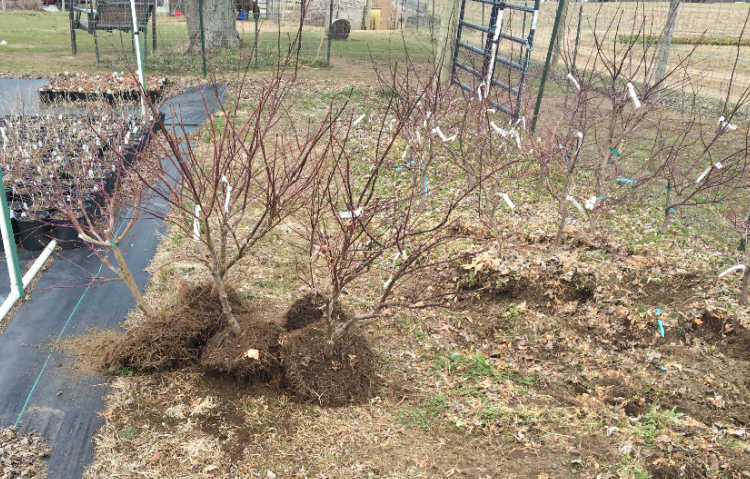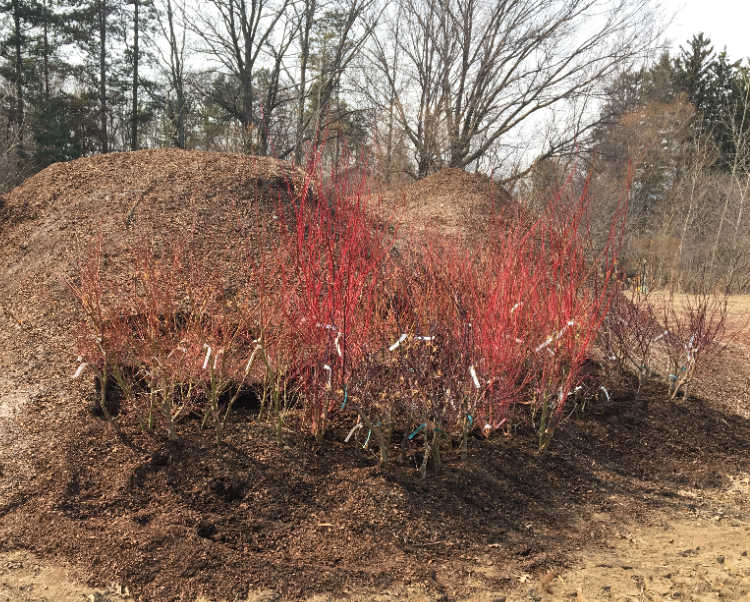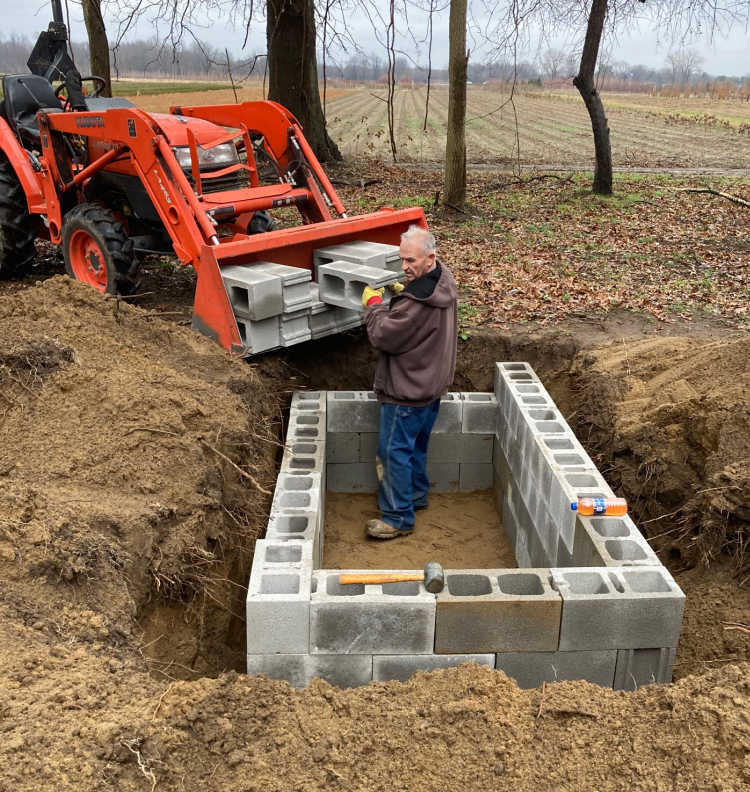
These are rules for digging trees and other plants.
- Only dig trees or plants when they are dormant. Here in Ohio dormancy occurs usually right before Thanksgiving, after we’ve had at least on night with temps down around 28 degrees F. or lower.
- That’s when digging season begins, and for us it usually ends about the third week of April in the spring. Once the plants start to make leaves digging and transplanting season is over.
- You can not dig a plant that has leafed out or has actively growing leaves on it.
- The size of the root ball you dig is based on the caliper of the trunk, measured 6″ above ground. For every one inch of trunk caliper you should have at least 11″ or 12″ of root ball.
- Bare root trees like you see in the above photo can not be left out in the open like that for very long at all.
- The bare roots should never be allowed to freeze while exposed to the air. Of course they freeze in the ground, but that’s different and it does not harm them. But if they freeze while exposed to the air they will be killed.
- They can not dry out. Once dug they need to be heeled back in and watered as quickly as possible. Anything more than an hour is not good and less than that is even better.
What to do with them until potting?

All I do dig into the potting soil pile a bit, put the trees into the trench or opening that I’ve made, place them root ball to root ball, then I cover the roots with potting soil.

Once they are heeled in like this there is not a great deal of urgency to get them potted as long as the roots stay moist. Of course the sooner you pot them the sooner they get established into the new pot. But if they leave out while in this holding place that’s not an issue because any root damage was done when they were dug. Potting should not be a traumatic experience for them.
I also sometimes store plants under ground, especially if I am going to have them over the winter and it’s too cold to get them potted. This video shows my first underground bunker.
Interestingly enough when I built this bunker I drove back into the brush and bramble at the back of the nursery and said to myself, “This is perfect, this is far enough back that it won’t interfere with anything.”
Wrong, I had to fill it in or else it would be in the middle of my now parking area!
And Here You Can See My New Underground Bunker.

Questions, comments, mean things to say? Post them below and I will respond. Until then, by any and all means stay inspired!
Hello Mike!
I have a Japanese maple, a Bloodgood. It’s hard to explain, but I need to move it about 20 inches. I’m guessing it’s about 15 feet high and wide. You say for the rootball 1 foot for every inch of circumference of the trunk. How deep will I need to go to make sure I don’t damage the roots?
Thank you Sir!
Regards,
Christian
Christian,
When digging or moving a tree you are going to damage the roots. But if you make the root ball the right size and the tree is dormant it will be fine. You’ll probably be going about 30″ deep.
Thank you for your response. I greatly appreciate it!😃
Caliper refers to the diameter, not circumference. One foot root ball diameter for every inch of trunk diameter.
Been learning a lot form you since google sent me to your stuff a year ago when I started a nursery. Since this post was about bare root, here’s my question: I have an opportunity to get bare root herbacious perennials from Missouri. I am in zone 4b Minnesota. Very different climate. Its in the single digits here and 50s there. They are digging dormant plants now. What is the best way to store them and keep them dormant until early April when I can heel them into a raised bed? Thanks!
Frank,
Local perennial grower used to dig their entire stock in late fall, then store them and ship them all winter in bins in a cold barn, but not freezing. The bare roots probably should not freeze. I know they freeze in the ground, but exposed to air is different. Keep them below 40 degrees and keep the humidity around them quite high. Bare root plants are stored inside at 90% humidity. But you have to be careful to not let them mold as well. It’s a fine line. I buy some bare root perennials but I can get them delivered in late March, early April while still dormant.
Thanks Mike. The seller told me they’d hold them till then this morning. Seems you all agree!
I am looking for young kinsville boxwood (2-5 years). Where can I find the source?
Thanks!
Ping,
I really don’t know, if you can’t find them online it’s possible that one of our members has them but I’m not familiar with the variety. And that’s why our members are so important, they find these rare plants and propagate them so they will always be available. http://backyardgrowers.com/join
Hi Mike, it doesn’t look like you reply to YouTube video so I thought I would ask here. I was wondering what size is mikes Plant Farm in Perry? And how is the acreage divided? How much do you have for sales and staging? How much do you have for growing in propagation? Any information is super helpful. I love your site and I’ve been learning a lot for several years now
Where can I get bulk Japanese Maples for $1.35 a piece like you did in one of your videos?
Jonathan,
Those maples are now about $1.85 each I think, I only reveal wholesale sources in the members area. http://backyardgrowers.com/join
What time of year do you take hardwood tree cuttings and plant/root them? Also what time of year do you transfer trees from beds to pots?
Alva,
I have found that the best time to do hardwood cuttings is right at the end of winter. Late March here in Ohio. Any kind of digging of plants must be done between Thanksgiving and early spring before the plants leaf out.
Thanks!
Also where do you store your plants right after you pot them?
Thanks!
Also where do you store the plants right after you pot them?
Alva,
Usually in the nursery. Some small plants if potted in mid summer go under shade.
Also where can I get Japanese maple seedlings for $1.35 apiece like you did in one of your videos?
Alva,
Those seedlings are now about $1.85 each as I recall. This is a question that I can only answer in the members area. http://backyardgrowers.com/join
How long do you wait before selling them after potting them up? I’ve been potting up bareroot trees and I’m just not sure how long to wait before selling them at our farm stand.
Thanks!
Josie,
I really don’t wait. Once potted they are for sale but I explain to the customers that they were just potted and will come out of the pot bare root.
Thanks!!!
How long after potting up do you wait to sell them? I’ve been potting up bareroot stock that I purchased and I’m not sure when to put them out for sale at our farm stand. thanks!
Is mulch ok to cover top roots ofa tree
I read where they breathe oxygen and shouldnt be covered
Phyllis,
Mulch should be fine. Roots exposed to the air will die. But they do breath oxygen through the soil or mulch.
You have lost a lot of weight! What is your secret?
Ann,
A little over a year ago I had weight loss surgery. Best decision I ever made.
Ahh reminds me of the good old days when I used to unload and heel in thousands of bare root plants in the late winter, in preparation for potting up when the weather (and soil) warmed up. I worked at a 13 or so acre production nursery. Miss those days: the physical exercise, fresh air, the smell of the soil and the mulch (that earthy smell is like perfume; it still kicks in the olfactory senses and memories).
I’ve been subscribing to you for years, Mike!
Keep up the good work, keep on gardening!
Donna,
Thank you for sticking with me all these years!
Something like an old fashioned root cellar?
Hi Mike,
My question is not related to your article, but about a fig tree.
Here in md it’s been pretty cold, and I was hoping to make some hardwood transplants. How do I know the cutting I take is not dead. I havnt done any yet. I was hoping to cut some when it’s a little warmer and the ground is thawed out.
Please advice.. thank you
Yasmin,
Great question and I don’t think you can tell until it warms up and it’s to late. Often times winter damage occurs but the tissue below the bark looks fine until it warms up and the plant is expected to break dormancy. Then all of a sudden the tissue gets soft and mushy and it’s obvious the plant is dead.
Thank you, Mike, for the “transplant trees and bushes only while they’re dormant” advice. I have lots of seedlings that sprout in my yard, and I tried many times to transplant them, with limited success until finding the “dormant only” gem in your teachings. Since then, it’s sometimes hard to be patient and wait for winter, but I’ve done it, and I’ve been extremely successful with my transplants.
One other really important rule is to root-prune your shrubs each year they are in the field. Cutting down around the perimeter of the root-ball the depth of a flat bladed digging shovel each year will prune longer roots and force them to branch out within the root-ball. The result is lots of fine roots and a much easier plant to dig.
Dave is right about root pruning. It really depends on the plant, things like Burning Bush and Rhododendron that naturally have very fibrous root systems don’t need it, but trees, even large evergreens benefit from it greatly. When you are growing a plant in the field and intend to dig that plant at a later date it does you no good to have all kinds of roots way out by the drip line of the tree since your root ball is going to be much smaller than that. Rooting pruning a year or two in advance of actually digging the tree forces a lot more fibrous root growth with in the area that will make up the root ball.
What time of year is this root-pruning done? I have several little seedling peach trees, and a not-so-little one, as well as two grafted peaches bought from an outfit in California three years ago, that will be transplanted HOPEFULLY this fall. Most have already bloomed and are now leafing-out. The three smallest are right next to a fence. Also have 13 honeyberry/haskap bushes of varying sizes, as well as a couple other small trees, that have been in place for about 3 years that will need to be transplanted, too. I’m in central NYS, zone 6a.
Becky,
Root pruning is best done when the plants are dormant so you don’t shock the plants. When growing seedlings etc. they can be automatically root pruned via air pruning using bottomless containers sitting on a wire bench. When the roots poke out the bottom of the container the air kills the tip of the root and presto! The plant is root pruned.
Over a 6 year period, I have planted about 40 trees at a local park. I agree trees should be planted when they are dormant. Some trees planted during the growing season go into shock and die or grow poorly. Small trees should either have the lower part painted white or tree wraps used. The reason for this is the winter sun can defrost the tree on one or two sides. The tree re-freeze which can kill the tree on the one side
Mike my daughter lives in Greer SC. She has a beautiful Fig tree in her yard but it is right next to her pear tree only about 5 feet away. It has never been taking care of properly. what is the correct way to
1- dig it up
2- possibly splitting it into 2 or more trees
3- replant it in a different location?
I live in Vermont and am only in SC in June – July and again in December -January
Appreciate any advice you can give me
Fred,
It would have to be dug while dormant, which is now. Splitting it is probably not an option since they are single crown plants. Just dig around the root ball, leaving 12″ of root ball for every one inch of stem caliper.
Your idea for an underground bunker is very interesting. I would like to see more pictures as to how you would use it. It looks like a possible way to winter store dug up one year old grafted apple tree seedlings for very early spring transplanting. I presume only the roots and possibly the graft would need to be covered and would semi-rotted wood chips be a good medium? Made high enough with a roof over it, the trees within would be rodent proofed.
David,
You’re right, just cover the roots with wood chips. Making it higher will expose it to more cold air and it will lose it’s ability to stay above freezing. As you see it it stays warm naturally from the ground heat.
Hi, Mike,
Always enjoy your articles. Appreciate your knowledge and willingness to share your plant wisdom.
It might be helpful to remind folks not to use non-ramial wood as a soil-builder or mulch if wood chips used for mulch will be turned into the soil, since it will deplete rather than build the soil. Those chips should always be ramial, also known as ‘arborist’s chips’. Ramial wood being wood chips from small branches no bigger than 2 3/4 inches in diameter.
Kevin,
I’d love to show you a pile of the most beautiful compost you’ve ever seen and it’s made up of at least 50% tree chips from a tree service that are completely broken down. This stuff is so nice that I could actually pot with it if I wanted to. Yeah, I’ve changed my thinking and understand of tree chips over the years.
Did you know that apple tree seedlings probably won’t produce the same kind of apples that they sprouted from? Strange, but true. However, free apple trees are better than none.
I would put some Warfrin in there just in case. Those greedy little guys are devious!
Charline,
You’re right about mouse bait. They can do a lot of damage.
Do you mean heeling?Orchidlady